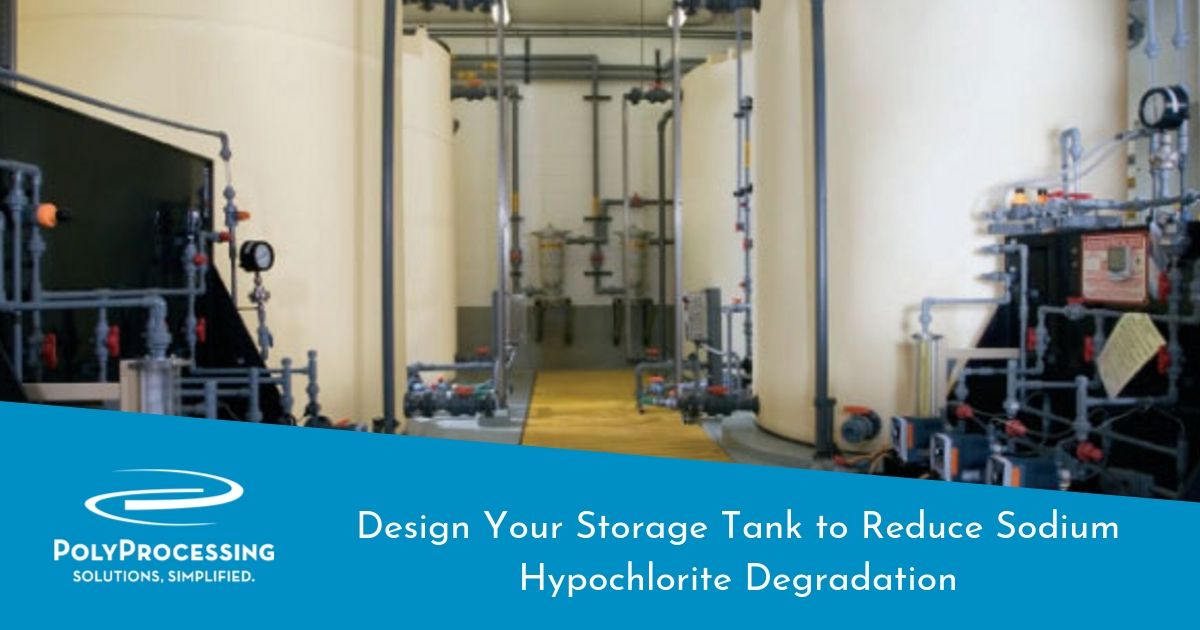Design Your Storage Tank to Reduce Sodium Hypochlorite Degradation
Commercial sodium hypochlorite is the product of chlorine and sodium hydroxide. It is typically supplied as a liquid solution with a concentration of about 12%. Although the liquid solution is more expensive than gas, it has a lower health risk, it’s easier and safer to use, and it reduces the risk of releasing chlorine gas — especially in areas that are close to surrounding properties.

Sodium hypochlorite is chemically unstable and gradually converts to sodium chlorate. Caustic soda is added to the commercial product to improve stability, but certain factors can affect the degradation of sodium hypochlorite. These include:
- The presence of certain metals, such as iron, copper, cobalt or nickel
- Exposure to UV light or sunlight
- High temperatures over time
Poly Processing has developed a chemical tank system for sodium hypochlorite solutions that mitigates degradation due to metals, UV exposure and high temperatures. Our cross-linked polyethylene chemical tanks preserve your bulk sodium hypochlorite longer and lower your replacement costs.
Preventing Metal Buildup
Sodium hypochlorite typically contains transition metals, such as nickel, iron, and copper. If these build up in a chemical storage tank, you run the risk of creating off-gassing, which can be dangerous to your employees, your environment, and your tank.
To address this challenge, Poly Processing developed the Integrally Molded Flanged Outlet®, or IMFO® system. The flange is at the bottom sidewall of the tank, achieving full drainage and flushing transition metals from the tank before refill. The tank’s design offers the highest net positive suction head of any vertical non-conical tank.
IMFO® tanks also minimize bulkhead and traditional sidewall fittings, reducing oxidation. The full-drain flange is molded into the polyethylene plastic tank, so there are no metal components that come in contact with the oxidizing solution.
Protecting Sodium Hypochlorite from UV Rays
Of course, UV exposure is only a threat if your chemical storage tank is located outside. However, because of their variety of uses, many of our customers store our tanks indoors and outdoors.
The chemical structure of sodium hypochlorite breaks down when exposed to UV rays. To prevent this breakdown, we recommend using a black tank or painting your tank. A carbon black tank helps to block out UV rays during the day, without significantly increasing the temperature of the chemical.
Mitigating Temperature Degradation
Because painting the tank prevents UV rays from entering the tank, it also helps keep the chemical temperature lower. If your tank is outdoors and you’re located in a hot area like Arizona or Florida, we often recommend insulating the tank to protect from ambient heat. We spray two inches of foam insulation on the tank, then cover it with a mastic coating.
Additional Storage Considerations for Sodium Hypochlorite
Another innovative storage solution for sodium hypochlorite is our exclusive OR-1000™ system. The OR-1000 is a chemical storage tank with an engineered inner surface specifically formulated to resist oxidation. Its outer surface is made of XLPE, high-density crosslinked polyethylene, for superior strength. The two surfaces are molecularly bound together during the roto-molding process, creating a truly seamless bond between the XLPE and the inner surface of the polyethylene tank.
With the IMFO®, full tank drainage is accomplished, and the one-piece molded tank construction minimizes the need for any other sidewall connections. In addition, the OR-1000 minimizes the potential for oxidation to the wetted surfaces of the tank. With this one-two punch, Poly Processing offers the superior storage solution for sodium hypochlorite. Poly Processing is the only company to offer a published warranty of over one year for sodium hypochlorite storage systems.
Download the sodium hypochlorite storage system guide for more information.
- September 23, 2019
- Topics: Chemicals
About Poly Processing
Posts By Topic
Tech Talk Podcast Episodes
Subscribe By Email
Recent Posts
- Installation Tips for Chemical Storage Tanks: Site Preparation and Offloading
- Understanding pH and Chemical Concentration When Choosing a Chemical Tank
- Maximizing Fill Efficiency: Selecting the Optimal Fill Line System
- Chemical Storage Tanks: A Quick Guide for End Users
- Popular Customization Options for Chemical Storage Tanks
Tank Configurator

Find the recommended tank and system components for your chemical storage challenge.
Configure a Tank Package



